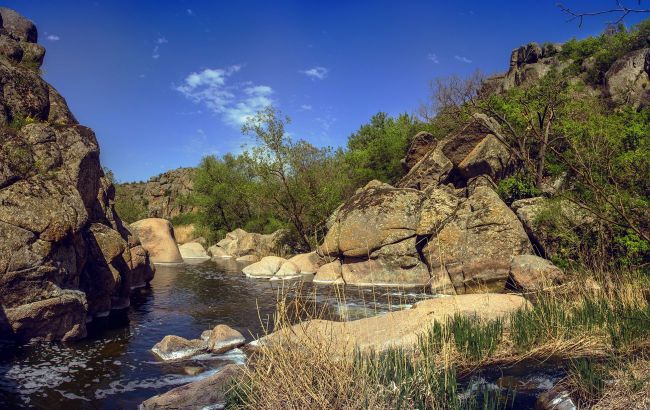This magical Ukrainian canyon was sacred to warrior sorcerers - And you can still visit
 Where the Devil's Canyon is located and why every Ukrainian should see it (Photo: wikimedia.org/Zysko_serhii)
Where the Devil's Canyon is located and why every Ukrainian should see it (Photo: wikimedia.org/Zysko_serhii)
Hidden among the rocky expanses of the Mykolaiv region lies a natural wonder—Aktove Canyon. This deep gorge on the Mertvovod River, with its granite cliffs, ancient boulders, and legends from the Scythian era, is no less impressive than the famous American Grand Canyon. What makes this jewel of the Mykolaiv region special, and why is it considered mystical?
Where the Devil's Canyon is located
In the heart of the Mykolaiv region, near the village of Aktove, nature has carved out one of the most stunning landscapes in Ukraine—Aktove Canyon. Here, time, water, and wind created a grand stone symphony—a deep gorge also known as the "Devil's Canyon."
The canyon is cut through by the Mertvovod River and has a depth of over 50 meters. Granite cliffs covered in rare plants, massive boulders resembling frozen waves of an ancient sea, and the picturesque riverbed form a unique mosaic of natural contrasts.
 Aktove Canyon, with the Mertvovod River in the foreground (Photo: Wikipedia)
Aktove Canyon, with the Mertvovod River in the foreground (Photo: Wikipedia)
History and legends of the canyon
This complex is more than just a geological monument. It's an entire world: Aktove Canyon, the Trykraty labyrinth forest, and the untouched waters of the Mertvovod create a natural ecosystem that captivates at first glance.
At sunrise, the light touches the tops of the cliffs, painting them in a soft peach hue, turning the canyon into a fairy-tale landscape.
Since ancient times, the Mertvovod River was not only a waterway but also a path to the afterlife. Ancient Scythians floated the bodies of deceased rulers down this river, surrendering them to eternity.
 Aktove Canyon (Photo: Wikipedia)
Aktove Canyon (Photo: Wikipedia)
According to Cossack legends, "kharakternyky" (mystic warriors) knew the secret power spots in Aktove Canyon and trained here to gain superhuman abilities.
It is said that mysterious capsules are hidden in the granite rocks, where warriors could transform into beasts. Some even claim that if you look closely, you can see the shadows of Cossacks or Turkish soldiers—phantoms wandering the gorge.
These lands witnessed fierce battles, and the canyon's rocks still hold the voices of history, as a guardian, a memory, a final refuge for restless souls.
Aktove Canyon has long been a magnet for adventurers: photographers, climbers, thrill-seekers, and all those who crave communion with unspoiled nature.
 The Devil's Canyon and valley (Photo: Wikipedia)
The Devil's Canyon and valley (Photo: Wikipedia)
How the Devil's Canyon was formed
This canyon is one of the oldest land formations in Europe, created from volcanic rock.
Scientists say this area was covered by the sea around 60 million years ago. The valley emerged due to a rupture in a massive granite shield, and the rock formations here are estimated to be over four billion years old.
Locals call this canyon "Little Crimea" because the granite-basalt cliffs resemble those in Crimea.
While its size is smaller than the Grand Canyon's, its beauty rivals that of the world's most famous gorges.
 Aktove Canyon near the village of Aktove (Photo: Wikipedia)
Aktove Canyon near the village of Aktove (Photo: Wikipedia)
Today, this unique area is protected as part of the Bug Gard National Nature Park. It is part of Ukraine’s natural and spiritual heritage, one that must be preserved—not only for ourselves but for future generations.
Interesting facts about the Devil's Canyon
- Located on the crystalline shield on the oldest piece of land in Europe, near the village of Aktove
- Nearby are two more canyons: Arbuzynka and Petropavlivka
- The canyon consists of granite boulders and cliffs reaching 50 meters in height and spans an area of about 250 hectares
- Ancient Greeks called this canyon "Exampaeus," meaning "dead water"—the Mertvovod River has such a high concentration of hydrogen sulfide that it kills all life in the water
- In winter, the Mertvovod freezes, and frost covers the cliffs, creating a breathtaking scene
- In spring, mountain tulips bloom in the canyon, rarely seen elsewhere in Ukraine
 Devil's Canyon (Photo: Wikipedia)
Devil's Canyon (Photo: Wikipedia)
You may be interested in:
- Top 5 Ukrainian villages that will impress you more than European resorts
- Why you should see the Akkerman Fortress at least once in your life
- Culinary routes across Ukraine that are just as impressive as those in Italy
Sources: Wikipedia, Ukranorama, TDM

